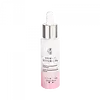What's inside
What's inside
 Key Ingredients
Key Ingredients

 Benefits
Benefits

 Concerns
Concerns

 Ingredients Side-by-side
Ingredients Side-by-side

Water
Skin ConditioningGlycerin
HumectantDiglycerin
Humectant1,2-Heptanediol
Skin ConditioningCarpobrotus Edulis Extract
Aloe Barbadensis Leaf Juice Powder
Skin ConditioningCaprylyl Glycol
EmollientGellan Gum
Polyglyceryl-4 Caprate
EmulsifyingPolyglyceryl-6 Caprylate
EmulsifyingParfum
MaskingHyaluronic Acid
HumectantSodium Hyaluronate
HumectantCalcium Chloride
AstringentTrisodium Ethylenediamine Disuccinate
Citric Acid
BufferingSodium Hydroxide
BufferingWater, Glycerin, Diglycerin, 1,2-Heptanediol, Carpobrotus Edulis Extract, Aloe Barbadensis Leaf Juice Powder, Caprylyl Glycol, Gellan Gum, Polyglyceryl-4 Caprate, Polyglyceryl-6 Caprylate, Parfum, Hyaluronic Acid, Sodium Hyaluronate, Calcium Chloride, Trisodium Ethylenediamine Disuccinate, Citric Acid, Sodium Hydroxide
Water
Skin ConditioningPropylene Glycol
HumectantAlcohol
AntimicrobialDiglycerin
HumectantPentylene Glycol
Skin ConditioningCentaurea Cyanus Flower Water
Skin ConditioningNiacinamide
SmoothingSodium Ascorbyl Phosphate
AntioxidantPolyglyceryl-10 Laurate
Skin ConditioningInositol
HumectantSodium Hyaluronate
Humectant1,2-Hexanediol
Skin ConditioningCaprylyl Glycol
EmollientSodium Citrate
BufferingCitric Acid
BufferingParfum
MaskingLinalool
PerfumingMannan
Sodium Benzoate
MaskingPotassium Sorbate
PreservativeWater, Propylene Glycol, Alcohol, Diglycerin, Pentylene Glycol, Centaurea Cyanus Flower Water, Niacinamide, Sodium Ascorbyl Phosphate, Polyglyceryl-10 Laurate, Inositol, Sodium Hyaluronate, 1,2-Hexanediol, Caprylyl Glycol, Sodium Citrate, Citric Acid, Parfum, Linalool, Mannan, Sodium Benzoate, Potassium Sorbate
 Reviews
Reviews

Ingredients Explained
These ingredients are found in both products.
Ingredients higher up in an ingredient list are typically present in a larger amount.
Caprylyl Glycol is a humectant and emollient, meaning it attracts and preserves moisture.
It is a common ingredient in many products, especially those designed to hydrate skin. The primary benefits are retaining moisture, skin softening, and promoting a healthy skin barrier.
Though Caprylyl Glycol is an alcohol derived from fatty acids, it is not the kind that can dry out skin.
This ingredient is also used as a preservative to extend the life of products. It has slight antimicrobial properties.
Learn more about Caprylyl GlycolCitric Acid is an alpha hydroxy acid (AHA) naturally found in citrus fruits like oranges, lemons, and limes.
Like other AHAs, citric acid can exfoliate skin by breaking down the bonds that hold dead skin cells together. This helps reveal smoother and brighter skin underneath.
However, this exfoliating effect only happens at high concentrations (20%) which can be hard to find in cosmetic products.
Due to this, citric acid is usually included in small amounts as a pH adjuster. This helps keep products slightly more acidic and compatible with skin's natural pH.
In skincare formulas, citric acid can:
While it can provide some skin benefits, research shows lactic acid and glycolic acid are generally more effective and less irritating exfoliants.
Most citric acid used in skincare today is made by fermenting sugars (usually from molasses). This synthetic version is identical to the natural citrus form but easier to stabilize and use in formulations.
Read more about some other popular AHA's here:
Learn more about Citric AcidDiglycerin is a humectant. It is derived from glycerin, which is naturally found in your skin.
As a humectant, it helps draw moisture to the skin from the air.
Parfum is a catch-all term for an ingredient or more that is used to give a scent to products.
Also called "fragrance", this ingredient can be a blend of hundreds of chemicals or plant oils. This means every product with "fragrance" or "parfum" in the ingredients list is a different mixture.
For instance, Habanolide is a proprietary trade name for a specific aroma chemical. When used as a fragrance ingredient in cosmetics, most aroma chemicals fall under the broad labeling category of “FRAGRANCE” or “PARFUM” according to EU and US regulations.
The term 'parfum' or 'fragrance' is not regulated in many countries. In many cases, it is up to the brand to define this term.
For instance, many brands choose to label themselves as "fragrance-free" because they are not using synthetic fragrances. However, their products may still contain ingredients such as essential oils that are considered a fragrance by INCI standards.
One example is Calendula flower extract. Calendula is an essential oil that still imparts a scent or 'fragrance'.
Depending on the blend, the ingredients in the mixture can cause allergies and sensitivities on the skin. Some ingredients that are known EU allergens include linalool and citronellol.
Parfum can also be used to mask or cover an unpleasant scent.
The bottom line is: not all fragrances/parfum/ingredients are created equally. If you are worried about fragrances, we recommend taking a closer look at an ingredient. And of course, we always recommend speaking with a professional.
Learn more about ParfumSodium Hyaluronate is hyaluronic acid's salt form. It is commonly derived from the sodium salt of hyaluronic acid.
Like hyaluronic acid, it is great at holding water and acts as a humectant. This makes it a great skin hydrating ingredient.
Sodium Hyaluronate is naturally occurring in our bodies and is mostly found in eye fluid and joints.
These are some other common types of Hyaluronic Acid:
Learn more about Sodium HyaluronateWater. It's the most common cosmetic ingredient of all. You'll usually see it at the top of ingredient lists, meaning that it makes up the largest part of the product.
So why is it so popular? Water most often acts as a solvent - this means that it helps dissolve other ingredients into the formulation.
You'll also recognize water as that liquid we all need to stay alive. If you see this, drink a glass of water. Stay hydrated!
Learn more about Water